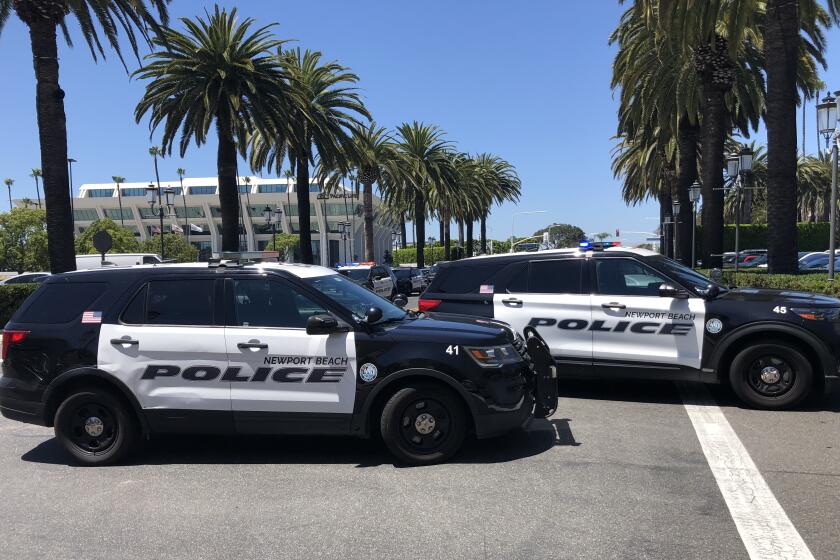Council aims to cut PERS debt
- Share via
City officials began Tuesday to consider ways to lower the crippling interest payments the state charges for retroactive retirement benefit increases for firefighters, police officers and lifeguards.
City Manager Ken Frank offered some options at Tuesday’s meeting that would help the city reduce the interest mandated by the state to pay off the huge debt for emergency personnel’s service before the increase. The state charges 7.75% annual interest.
“This may be one of the most important agenda items of the entire year,” Frank said. “The ramifications go out 14 years into the future.”
Although payments have been made to reduce the debt, the city still owes about $9,865,000. Annual payments will increase from $960,000 this fiscal year, most of which is interest, to an estimated $1.4 million in 2022, the final year the state set to pay the debt.
“When it is all done, the city will have paid approximately $6.4 million in interest to PERS at the 7.75% rate,” Frank said.
That’s in addition to the original debt, bringing the total to more than $16 million.
The city does not make anywhere close to 7.75% interest on its investments, particularly on the $13 million in the state pool, which pays a measly seven-tenths of a percent interest. On the other hand, the city didn’t lose 25% of its investment portfolio like PERS did last year, Frank said.
And other city investments earn more. City Treasurer Laura Parisi has invested a substantial portion of the city’s $60-million portfolio in federal agency notes that earn somewhere in the 2% to 3% range, averaging out to 1.5%.
It’s still a losing proposition. The city would save a substantial amount of interest by paying off the PERS debt immediately, Frank told the council.
Parisi suggested the city might also try to renegotiate the debt, a suggestion well received by the council.
If the council does nothing else, Frank suggested floating taxable bonds, at a probable rate of 6%, to make the payments, not much of a savings.
“But I think there is a better option,” Frank said.
Of the seven options he outlined, Frank favored borrowing from surpluses in funds that are not imminently needed and repaying them, either with or without interest.
Examples of possible funding sources and amounts, not recommendations:
Vehicle Replacement Fund, $500,000
Insurance Fund, $500,000, while still maintaining funding for liability and workers’ compensation
Street Lighting, $1 million
Parking Authority, $2 million
Disaster Relief, $2.5 million.
Capital Improvements, $1.5 million
General Fund, $2 million.
Under Frank’s internal loan Option 3b, the city would make payments of the same amount it would otherwise pay to PERS, but the debt would be retired in about nine years rather than 14. If the city paid itself 1.5% interest on the internal loan, the debt would be paid off in 10 years.
“Future councils would love this option because they would have another $1 [million] to $1.4 million to spend each year, but it does nothing for the city’s short-term financial health while the current council makes sacrifices to cobble together the $10 million,” Frank said.
“Of course, it could be argued that the debt should not be passed on to a future generation as it was incurred for service as long as 30 years ago.”
Under Frank’s option 3c, the payments would be made for 14 years, but without interest, a savings of $270,000 a year in the short term and as much as $700,000 a year down the line.
“If the council elected to pay interest at 1.5%, the annual rate would be about $800,000. Frank said. “This has some short- and long-term benefits.”
Frank said either option would be prudent, but 3c seemed the most viable to him.
“I am not asking for final action tonight, but I want your thoughts,” Frank said.
No one liked Option 3a, which borrowed from the funds, but did not repay the loans.
Councilwoman Verna Rollinger supported the notion of not paying the 7.75% interest, but wanted to be sure the loans would be repaid.
“Paying 7.75% is a disaster,” Councilwoman Jane Egly said. “Juggle the funds as long as they are repaid.”
Mayor Pro Tem Toni Iseman urged caution.
“Let’s bat this around,” she said.
Iseman opined that the city should take advantage of the economy’s lowering effect on bids. She didn’t want any delays on projects that would cost more five years from now. Frank agreed.
“We are looking at projects we can accelerate,” Frank said.
He assured the council that money would be taken only from funds that were sitting idle, with projects that have funds allocated, but not to be spent in the immediate future, such as the Marine Safety Headquarters, which must still go through the lengthy California Coastal Commission process.
Mayor Elizabeth Pearson said she would not consider borrowing from either the Disaster Fund, for which the voters approved a temporary tax, or from the Parking Fund.
Frank said he hoped to get a read on the public’s opinion of reducing the interest payments.
By consensus the council tabled the item for future consideration.
All the latest on Orange County from Orange County.
Get our free TimesOC newsletter.
You may occasionally receive promotional content from the Daily Pilot.







